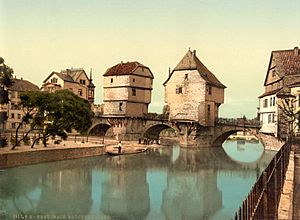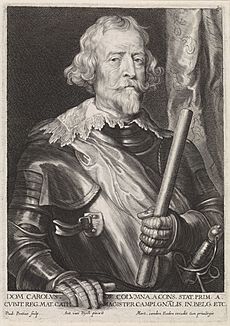Siege of Kreuznach facts for kids
Quick facts for kids Siege of Bad Kreuznach |
|||||||
|---|---|---|---|---|---|---|---|
| Part of the Palatinate phase of the Thirty Years' War | |||||||
 Old Nahe Bridge, Bad Kreuznach |
|||||||
|
|||||||
| Belligerents | |||||||
| Commanders and leaders | |||||||
| Strength | |||||||
| 5,000 infantry 300 cavalry 4 cannons |
~3 infantry companies ~1 company of cavalry |
||||||
| Casualties and losses | |||||||
| None | None | ||||||
The Siege of Kreuznach was a battle that happened on September 10, 1620. It took place in a town called Kreuznach, which is now known as Bad Kreuznach in Germany. During this battle, the Spanish Army of Flanders, led by Don Ambrosio Spinola, defeated the soldiers of Frederick V. Frederick V was a ruler known as the Elector of the Palatinate. This event was part of the Palatinate campaign during the Thirty Years' War.
The Army of Flanders was a large army that served the kings of Spain. It was made up of soldiers from many different countries. Spinola's troops attacked Bad Kreuznach, and the soldiers defending the town gave up. After the battle, the town was allowed to be free. However, its people had to promise not to fight against the Holy Roman Empire.
Why the Siege Happened

The Thirty Years' War started in 1618. It began when a region called Bohemia offered its throne to Frederick V of the Palatinate. Frederick V was a Protestant leader. When he accepted, it started a big fight. This conflict was between the Protestant Union, led by Frederick, and the Catholic House of Habsburg.
Two years into the war, things seemed stuck. But the Habsburgs, who were Catholic rulers, worked behind the scenes. They managed to make Frederick V lose his allies. Spain then joined the fight, which was a big problem for Frederick.
In August 1620, Spinola and about 25,000 soldiers from the Army of Flanders began marching. They started from Brussels. By early September, they entered the Lower Palatinate region. They quickly took over towns like Bad Kreuznach and Oppenheim. Later, on October 1, they also captured Bacharach.
Frederick V had not yet started fighting against Spain directly. So, Spinola tried to take over the main towns in the Palatinate as peacefully as possible. On September 8, Spinola marched his army towards Frederick's forces near Oppenheim. That night, he gave an order to his Field Marshal, Don Carlos II Coloma. Coloma was to take Kreuznach. He had about 5,000 foot soldiers and 300 horsemen. Kreuznach was important because it had a strong, fortified bridge over the Nahe river. It also had Kauzenburg Castle, which looked over the town.
The Attack on Kreuznach
Don Carlos Coloma and his soldiers reached the town gates on the evening of September 10. He sent messengers to the town leaders. He told them that if they gave up to Emperor Ferdinand II, they would be treated well. The town's defenders did not give a clear answer. So, Coloma ordered his four cannons to be set up. He moved his soldiers close to the town walls and the main gate, ready to attack.
The defenders of Kreuznach had about three groups of foot soldiers and one group of horsemen. They decided to fight back. They fired their muskets from the castle above the town. The Army of Flanders, in perfect order, fired back with their cannons. Just a few minutes later, the soldiers defending the town decided to surrender. The Army of Flanders took the horses and weapons from Frederick's soldiers. Coloma then made Frederick's troops promise not to fight against the Emperor anymore.
What Happened Next
After Kreuznach fell, Spinola continued his march with his army. He moved through the Palatinate to Alsheim, another important city in the area. He captured Alsheim on the same day. Four days later, on September 14, Spinola used a clever trick. He made it seem like he was going to attack Worms. This allowed him to capture Oppenheim easily. This was a big defeat for the Protestant forces.
See also
 In Spanish: Captura de Bad Kreuznach para niños
In Spanish: Captura de Bad Kreuznach para niños

